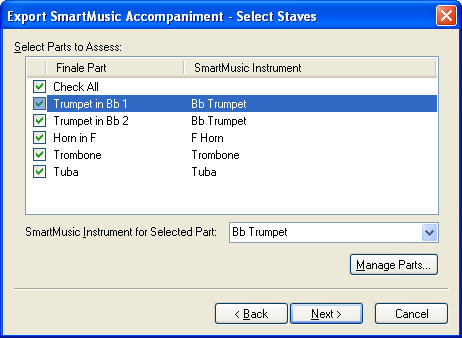If you want to take advantage of SmartMusic’s
assessment feature (which is capable of evaluating a live performance
for accuracy) and wish to include accompaniment during SmartMusic’s assessment,
do the following.
- Enter/edit the notation for the solo and accompaniment
staves. Some notation elements are not compatible with SmartMusic. In order to ensure compatibility, you can consult the SmartMusic Compatibility Guidelines. However, if there are any compatibility issues, Finale will check the file automatically and list conflicts as part of every SmartMusic Export procedure.
- Add the Appropriate SmartMusic Performance Markers. SmartMusic Performance
Markers such as pauses for fermatas are indicators used by SmartMusic
to allow the soloist more control over the performance. They can also
be used to display useful information to the soloist in the SmartMusic
interface, such as a rehearsal letter. For information on adding SmartMusic
Markers, see SmartMusic
Performance Markers.
- When you are ready to save the accompaniment, choose File > Export to SmartMusic. The Export SmartMusic Accompaniment - Select File Type dialog box appears.
- Choose Assessment, and click Next. The Select Staves page appears. This page displays all of the parts in the document.
- Check all the parts you wish to assess. Then, ensure the appropriate corresponding instrument is selected for each part in the drop-down menu below. Choose as many parts as you like. You can select which one you would like to assess in SmartMusic later.

Use the drop-down menu to make sure the Finale Part is assigned to the appropriate SmartMusic instrument. Finale draws information for SmartMusic Accompaniments from the linked part definition. To change the properties of a part, such as the name or staff assignment, click the Manage Parts button. See Manage Parts dialog box.
- Click Next. The Select Accompaniment Staves page appears.
- Check all parts you wish to include in the accompaniment. SmartMusic will mute the solo staff automatically during the performance.
- Click Next. The File Information Page appears.
- Confirm the Title, Composer, and
Copyright and click Finish. Finale automatically populates this dialog box with information from the File Info tab of the Score Manager. After you click Finish, Finale checks the file for compatibility with SmartMusic. If there are any notation elements that SmartMusic does not accommodate, you will see the SmartMusic File Compatibility dialog box. If not, you will see the Save SmartMusic Export File As dialog box (and can skip the next step).
Tip. Changes to the title, composer, and copyright made here do not apply to the Finale file in any way. This information is stored for the SmartMusic Accompaniment separately.
- Click each conflict to view a description on the right side of this dialog box. Click Edit to restore focus to the document where you can resolve these conflicts on the fly. Then click Check Again to confirm they have been resolved. See SmartMusic File Compatibility dialog box. When you have resolved all conflicts, click Done to return to the score. Then, choose File > Export to SmartMusic to complete the saving process.
Tip. Finale allows you to save the SmartMusic Accompaniment without resolving all conflicts. Review the SmartMusic Compatibility Guidelines or the description on the right side of this dialog box for details regarding the effects of each conflict.
- Name the file, choose a location, and click Save to save the SmartMusic Accompaniment. You can now open SmartMusic and open the assessable .SMP accompaniment file you've just saved.


